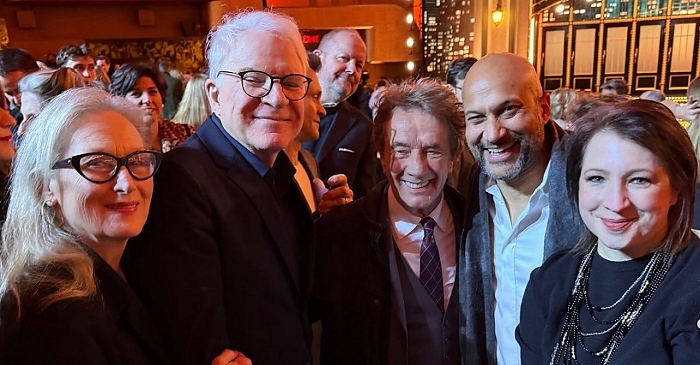
|
Review: Mirror, Mirror on the Screen
The New York Times ·
November 27, 2013
· Written by Michael Cieply
|
More than any performer of her era, Meryl Streep, 64, has reflected the hopes and fears of her moviegoing contemporaries, who have aged with her and seen their lives reflected in the roles she played, decade by decade.
They might be stunned by what they see in her latest portrayal, that of Violet Weston, the diseased harridan of “August: Osage County,” the movie version of the Pulitzer Prize-winning play by Tracy Letts, directed by John Wells. The movie is already appearing at film festivals around the country, as the producers seek to build momentum for an awards race that will soon hit full stride. If the character doesn’t scare off Ms. Streep’s admirers at the Academy of Motion Picture Arts and Sciences, she may be in line for her 18th Oscar nomination (she already holds the record in the acting category) and a fourth win. Scary or not, Violet Weston — she is the one being smashed to the floor by Julia Roberts on the movie poster — will again show Ms. Streep pointing the way for a graying generation. She is a mother from hell — she drinks, she pops pills, she’s dying too slowly for some — who is carrying out late-life reckonings with her children, a situation that may be familiar to her baby boomer peers.
“I’ve often thought of it as I watched her,” said Gail Sheehy, referring to the close congruence between Ms. Streep’s film roles and the generational crises Ms. Sheehy has described in her pop psychology hit “Passages” and later books. Mr. Wells, in a phone interview, said Ms. Streep was understandably cautious about taking a role that has much to say, and not in a pleasant way, about aging parents and their relationships with children.
“I’m going to have to live in this character for a significant period of time; is that a place I really want to go?” Mr. Wells said, describing Ms. Streep’s initial concerns. Mr. Streep’s roles have captured the personal and family dramas of many people who came of age in the late ’60s and early ’70s. When Ms. Streep was 30, the Vietnam-era ingénue she played in “The Deer Hunter” gave way to the troubled feminist, Joanna Kramer, in “Kramer vs. Kramer.” In that role, from 1979, Ms. Streep left her family in search of fulfillment, then returned to fight for custody of her son.
“It was exactly what so many women fired up by the women’s movement were feeling,” Ms. Sheehy noted of Ms. Streep’s performance, which also matched what her much-read book had labeled “Catch-30,” a predictable collision with the complications of adulthood. The film earned Ms. Streep a second Oscar nomination, and her first win, as best actress in a supporting role. (Three years later, she won her first best actress award for “Sophie’s Choice.”) Later, Ms. Streep was roused to action on behalf of a social cause in “Silkwood,” sought adventure in “Out of Africa,” and, as the writer Nora Ephron’s thinly veiled alter ego, Rachel Samstat, in “Heartburn,” saw her romantic illusions shattered, at the age of 36, by a philandering husband.
The early 40s brought implosion in “Postcards From the Edge.” But love bloomed again at 46 in “The Bridges of Madison County” (and then again in “It’s Complicated,” from 2009, and yet again, in “Hope Springs,” three years later). “The Devil Wears Prada,” shot in 2005, was about a professional crisis. It found Ms. Streep, at the age of 56, as the seemingly heartless fashion editor Miranda Priestly, fighting to save a threatened career. In “The Iron Lady,” as Margaret Thatcher, she then peered bravely ahead into dotage, and won a third Oscar, as best actress, in 2012.
Ms. Streep declined a request to discuss the arc of her career. But Laurence Mark, a producer of “Julie & Julia,” in which a 60-ish Ms. Streep played the cook and author Julia Child, said of her characters: “She never makes choices because it’s going to sell tickets, or just for the money. She makes choices because she’s just genuinely attracted to the role.” In “Julie & Julia,” Ms. Streep had her mentor moment, inspiring an understudy played by Amy Adams.
Now comes Violet Weston, and a final passage Ms. Streep’s fans may or may not want to share. On her good days, Violet wears a bad wig, on her bad days, she doesn’t bother. Never mind the cancer, she smokes. A lot. Gathered in rural Oklahoma for their father’s funeral, her daughters — played by Ms. Roberts, Juliette Lewis and Julianne Nicholson — try to wean her off the pills, but no one can stop her from speaking her brutally unfiltered mind.
“I’m just truth telling,” Ms. Streep’s Violet says in an online trailer. “Some people are antagonized by the truth.” Truth be told, the critics were split after “August: Osage County” screened at the Toronto International Film Festival in early September.
“With the unstoppable Streep in charge, it’s difficult for a viewer not to go along for the ride even if they’re a little uneasy (as I was),” wrote Steve Pond, who went thumbs up for The Wrap. “Streep plunges into Violet’s nuclear psyche so ferociously that there’s a slight danger of forfeiting our sympathies for good,” countered Tim Robey, in The Telegraph of London.
Since the film’s Toronto debut, the Weinstein Company has been delivering “August: Osage County” to the audience in small doses. The film has been showing up in a string of heartland film festivals, with screenings — without Ms. Streep, who is abroad filming “Into the Woods” — in Sarasota, Fla.; Asheville, N.C.; Scottsdale, Ariz.; Houston; the Napa Valley; and elsewhere. Lately, the Weinstein Company and its Oscar team have taken pains to tamp down reports that Ms. Roberts and Ms. Streep had been wrestling over which should be seen as the lead, and which as the supporting actress, for awards purposes. Asked whether such a scuffle had occurred, Mr. Wells said, “There was never a conversation that I participated in.” (The company has unambiguously positioned Ms. Streep as the lead, though Oscar voters can assign such honors as they see fit.)
But perhaps the deeper issue is whether those who have felt at one with so many of Ms. Streep’s roles — down and out in “Ironweed,” upside down in “Mamma Mia!” — are prepared to identify with a Violet Weston heading toward an ungentle end. Ms. Sheehy, for one, is ready for the ride.
“She’s going to be with us to the casket,” she said of Ms. Streep. “Thank goodness.”









